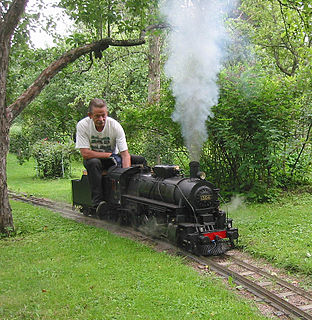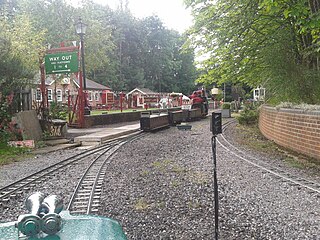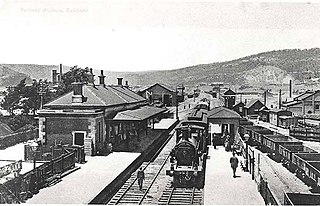
Railway modelling or model railroading is a hobby in which rail transport systems are modelled at a reduced scale.

A steam locomotive is a rail vehicle that provides the force to move itself and other vehicles by means of the expansion of steam. It is fuelled by burning combustible material to heat water in the locomotive's boiler to the point when it becomes gaseous and its volume increases 1,700 times. Functionally, it is a steam engine on wheels.
Rail terminology is a form of technical terminology. The difference between the American term railroad and the international term railway is the most significant difference in rail terminology. There are also others, due to the parallel development of rail transport systems in different parts of the world.

Live steam is steam under pressure, obtained by heating water in a boiler. The steam is used to operate stationary or moving equipment.

A ridable miniature railway is a large scale, usually ground-level railway that hauls passengers using locomotives that are often models of full-sized railway locomotives.
3801 is a 4-6-2 steam locomotive operated by the New South Wales Government Railways between 1943 and 1974. It is arguably Australia's most famous steam locomotive, being the only one to have visited all mainland states and territories.

The Moors Valley Railway is a 7+1⁄4 in narrow gauge passenger railway, in the Moors Valley Country Park at Ashley Heath, Dorset, England near Ringwood in Hampshire. There are 20 steam engines and 2 diesel engines. The railway is fully signalled, with two signal boxes, one in a Great Western Railway style and one in a British Rail Southern Region style. The latter box also contains a mini lever frame and push button panel, for the control of the Lakeside area. The railway was constructed at its present location in 1985/86 and opened to the public in July 1986, after the closure in 1985 of its predecessor at Tucktonia in nearby Christchurch, which had run since 1979.

Mechanical railway signalling installations rely on lever frames for their operation to interlock the signals, track locks and points to allow the safe operation of trains in the area the signals control. Usually located in the signal box, the levers are operated either by the signalman or the pointsman.

The Swanley New Barn Railway is a 7+1⁄4 in gauge railway located in Swanley Park, Swanley, Kent, United Kingdom. It is signalled throughout with the signals being controlled from New Barn Station which also serves as a terminus.

The Great Cockcrow Railway is a 7+1⁄4 in gauge miniature railway located near Chertsey, Surrey, UK. It is usually open on Sunday afternoons from May to October inclusive.

The 18 class was a class of 0-6-0T wheel arrangement steam locomotive built by Vulcan Foundry for the New South Wales Government Railways of Australia.
The Victorian Railways V Class is a steam locomotive, used on the Victorian Railways in the period 1900-1930.
The Queensland Railways C16 class locomotive was a class of 4-8-0 steam locomotives operated by the Queensland Railways.

Mizens Railway is a 7¼ inch gauge miniature railway located in a 10-acre site near Woking in Surrey, England. The railway comprises three routes, the longest being nearly 1 mile long. A variety of locomotives are in use, including several steam engines.

The Diamond Valley Railway is a 7+1⁄4 in ridable miniature railway located at Eltham Lower Park, Eltham, Victoria. The railway operates a variety of live steam, battery electric and petrol/diesel powered locomotives. It is run by volunteers and operates on every Sunday of the year, most public holidays and on Wednesdays during school holidays. The fare is AU$4.00 and one complete mainline journey takes about 12 to 15 minutes. It is a popular tourist attraction and carries over 150,000 passengers a year.

The Workshops Rail Museum is a railway museum in Ipswich, Queensland located within the former North Ipswich Railway Workshops.

Railway Signal Cabin and Turntable is a heritage-listed signal box at Ellenborough Street near the Ipswich railway station, Ipswich, City of Ipswich, Queensland, Australia. It was built from 1881 to 1895. It was added to the Queensland Heritage Register on 27 May 2005.

The Lithgow Coal Stage Signal Box is a heritage-listed former railway bridge and now railway signal box at Gas Works Lane, Lithgow, City of Lithgow, New South Wales, Australia. It was designed by New South Wales Government Railways and built from 1885 to 1925 by NSW Government Railways. The property is owned by RailCorp, an agency of the Government of New South Wales. It was added to the New South Wales State Heritage Register on 30 August 2013.

The Eskbank railway station is a heritage-listed former locomotive depot and railway station and now community group venue adjacent to the Main Western Line at Lithgow, City of Lithgow, New South Wales, Australia. It was designed by the New South Wales Government Railways and the station building was built by Goodsell & Wright, as a contractor. It is also known as Eskbank Railway Station group and Lithgow Goods Station/ Lithgow Site S1. The property was added to the New South Wales State Heritage Register on 2 April 1999.














